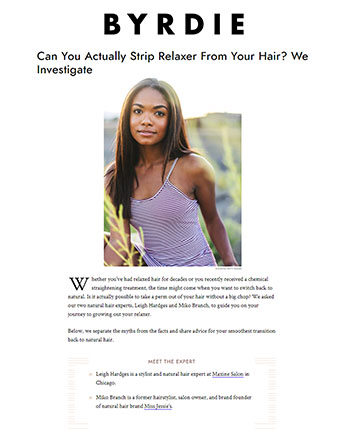Byrdie February 28, 2022
BYRDIE
Hair
Can You Actually Strip Relaxer From Your Hair? We Investigate
Whether you've had relaxed hair for decades or you recently received a chemical straightening treatment, the time might come when you want to switch back to natural. Is it actually possible to take a perm out of your hair without a big chop? We asked our two natural hair experts, Leigh Hardges and Miko Branch, to guide you on your journey to growing out your relaxer.
Below, we separate the myths from the facts and share advice for your smoothest transition back to natural hair.
MEET THE EXPERT
Leigh Hardges is a stylist and natural hair expert at Maxine Salon in Chicago.
Miko Branch is a former hairstylist, salon owner, and brand founder of natural hair brand Miss Jessie’s.
What is a Relaxer?
We know that a relaxer is used to straighten curly to natural hair types, but what is it exactly? "[Relaxer is] a permanent straightening system," explains Hardges. "The hairs bonds are broken using sodium hydroxide, while the hair is physically straightened. It is then rinsed and the bonds are reformed with a neutralizing agent."
Can You Strip a Relaxer From Hair?
The only answer to this question is "no." "There really is no such thing as stripping relaxer from hair because once texture has been removed, you can’t put it back," says Branch. "Any such process would significantly damage hair further. You can stop relaxing your hair, which will only effect the new growth, and will most likely have to address the remaining relaxed ends in some way, whether it be to add more texture via styling methods or cutting the relaxed ends off.”
How to Remove Relaxer From Hair
As previously mentioned, the chemicals used during a relaxing treatment break down the bonds in your hair in order to change the texture. What this means is no shortcut will be able to bring your natural hair back to life. In fact, the only surefire way to remove a relaxer is to cut off the processed hair, which is commonly referred to as “the big chop.” If you’re not comfortable with the idea of cutting your hair off, allow enough time to regrow your strands first. If you were wishing to wake up with new hair, this might not be the answer you want to hear, but it’s not as interminable as you might think.
Hair usually grows an average of half an inch per month, so in six months, with proper care, you should see around three inches of growth.
To add texture back to your hair or take the steps to embrace your natural hair texture, you can start with double strand twists or a curly rod set.
How to Style Hair While Transitioning to Natural Hair
"The point where the relaxed hair and naturally curly hair meets becomes very weak. If you continue to straighten the hair, the tension and heat applied will eventually cause the hair to snap at the transition point," says Hardges. "The best way to prevent this from occurring is to keep the hair curly and minimize manipulation of the hair as much as possible. Using protective styles such as sew-ins, twisting, rollers or a rod set will be optimal during the transition period. But you would still need to slowly trim the relaxed hair off."
To add texture back to your hair or take the steps to embrace your natural hair texture, you can start with double strand twists or a curly rod set if you're not quite ready for the big chop where Branch says the hair is typically cut closely to where natural hair has begun to grow back. Branch also recommends investing a styler made for curly hair and a diffuser. “Using Miss Jessie’s Multicultural Curls ($16) or Pillow Soft Curls ($22) on wet hair and scrunching in while diffusing can encourage as much curl as possible on relaxed hair. A few braids at night, loosened in the morning adds waves." If you're ready for a haircut, Branch says a short cropped haircut can double as a styling method and "look" while speeding up the process of removing relaxed hair as it’s cut off.

